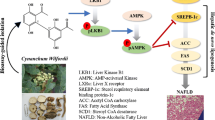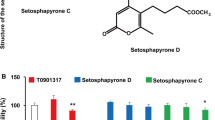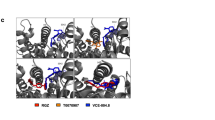Abstract
A novel liver X receptor (LXR) modulator, iristectorigenin B isolated from Belamcanda chinensis, stimulated the transcriptional activity of both LXR-α and LXR-β. In macrophages, iristectorigenin B suppressed cholesterol accumulation in a dose-dependent manner and induced the transcriptional activation of LXR-α/-β-responsive genes, ATP-binding cassette transporters A1 and G1. It did not induce hepatic lipid accumulation nor the expression of the lipogenesis genes sterol regulatory element-binding protein-1c, fatty acid synthase, and stearoyl-CoA desaturase-1. Iristectorigenin B thus is a dual-LXR agonist that regulates the expression of key genes in cholesterol homeostasis in macrophage cells without inducing hepatic lipid accumulation.





Similar content being viewed by others
References
Albers M, Blume B, Schlueter T, Wright MB, Kober I, Kremoser C, Deuschle U, Koegl M (2006) A novel principle for partial agonism of liver X receptor ligands—Competitive recruitment of activators and repressors. J Biol Chem 281(8):4920–4930
Aravindhan K, Webb CL, Jaye M, Ghosh A, Willette RN, DiNardo NJ, Jucker BM (2006) Assessing the effects of LXR agonists on cellular cholesterol handling: a stable isotope tracer study. J Lipid Res 47(6):1250–1260
Bulliyya G (2000) Key role of dietary fats in coronary heart disease under progressive urbanization and nutritional transition. Asia Pac J Clin Nutr 9(4):289–297
Costet P, Luo Y, Wang N, Tall AR (2000) Sterol-dependent transactivation of the ABC1 promoter by the liver X receptor/retinoid X receptor. J Biol Chem 275(36):28240–28245
Eu GH, Woo WS, Chung HS, Woo EH (2000) Isoflavonoids of Belamcanda chinensis (II). Korean J Pharmacogn 22:13
Geyeregger R, Zeyda M, Stulnig TM (2006) Liver X receptors in cardiovascular and metabolic disease. Cell Mol Life Sci 63(5):524–539
Grefhorst A, Elzinga BM, Voshol PJ, Plosch T et al (2002) Stimulation of lipogenesis by pharmacological activation of the liver X receptor leads to production of large, triacylglycerols-rich very low density lipoprotein particles. J Biol Chem 277(37):34182–34190
Hoang MH, Jia Y, Jun HJ, Lee JH, Lee DH, Hwang BY, Kim WJ, Lee HJ, Lee SJ (2012) Ethyl 2,4,6-trihydroxybenzoate is an agonistic ligand for liver X receptor that induces cholesterol efflux from macrophages without affecting lipid accumulation in HepG2 cells. Bioorganic Med Chem Lett 22(12):4094–4099
Joseph SB, McKilligin E, Pei L, Watson MA, Collins AR et al (2002) Synthetic LXR ligand inhibits the development of atherosclerosis in mice. Proc Natl Acad Sci USA 99(11):7604–7609
Jung SH, Lee YS, Lee S, Lim SS, Kim YS, Ohuchi K, Shin KH (2003) Anti-angiogenic and anti-tumor activities of isoflavonoids from the rhizomes of Belamcanda chinensis. Planta Med 69(7):617–622
Kratzer A, Buchebner M, Pfeifer T, Becker TM et al (2009) Synthetic LXR agonist attenuates plaque formation in apoE−/− mice without inducing liver steatosis and hypertriacylglycerolsmia. J Lipid Res 50(2):312–326
Lee JH, Cho B, Jun HJ, Seo WD, Kim DW, Cho KJ, Lee SJ (2012) Momilactione B inhibits protein kinase A signaling and reduces tyrosinase-related proteins 1 and 2 expression in melanocytes. Biotechnol Lett 34(5):805–812
Levin N, Bischoff ED, Daige CL, Thomas D, Vu CT, Heyman RA, Tangirala RK, Schulman IG (2005) Macrophage liver X receptor is required for antiatherogenic activity of LXR agonists. Arteriosclerosis Thromb Vasc 25(1):135–142
Peet DJ, Turley SD, Ma W, Janowski BA, Lobaccaro JM, Hammer RE, Mangelsdorf DJ (1998) Cholesterol and bile acid metabolism are impaired in mice lacking the nuclear oxysterol receptor LXR alpha. Cell 93(5):693–704
Quinet EM, Basso MD, Halpern AR, Yates DW, Steffan RJ et al (2009) LXR ligand lowers LDL cholesterol in primates, is lipid neutral in hamster, and reduces atherosclerosis in mouse. J Lipid Res 50(12):2358–2370
Schmitz G, Langmann T, Heimerl S (2001) Role of ABCG1 and other ABCG family members in lipid metabolism. J Lipid Res 42(10):1513–1520
Schultz JR, Tu H, Luk A, Repa JJ, Medina JC et al (2000) Role of LXRs in control of lipogenesis. Genes Dev 14(22):2831–2838
Wozniak D, Oszmianski J, Matkowski A (2006) Antimutagenic and antioxidant activity of the extract from Belamcanda chinensis (L.) DC. Acta Poloniae Pharm 63(3):213–218
Wu C, Li Y, Chen Y, Lao X, Sheng L, Dai R, Meng W, Deng Y (2011) Hypoglycemic effect of Belamcanda chinensis leaf extract in normal and STZ-induced diabetic rats and its potential active faction. Phytomedicine 18(4):292–297
Yamaki M, Kato T, Kashihara M, Takagi S (1990) Isoflavones of Belamcanda chinensis. Planta Med 56(3):335
Acknowledgments
We appreciate the technical assistance of Hea-Won Kim. This study was supported by the Korean Forest Service (Forest Science & Technology Project No. S120909L130110), the Technology Development Program for Fisheries of the Ministry for Food, Agriculture, Forestry and Fisheries, Republic of Korea (iPET, F20926409H220000110), and the Basic Science Research Program through the National Research Foundation of Korea (NRF) funded by the Ministry of Education, Science and Technology (20100028180).
Author information
Authors and Affiliations
Corresponding authors
Additional information
Hee-jin Jun and Minh-Hien Hoang contributed equally to study.
Electronic supplementary material
Below is the link to the electronic supplementary material.
Rights and permissions
About this article
Cite this article
Jun, Hj., Hoang, MH., Lee, J.W. et al. Iristectorigenin B isolated from Belamcanda chinensis is a liver X receptor modulator that increases ABCA1 and ABCG1 expression in macrophage RAW 264.7 cells. Biotechnol Lett 34, 2213–2221 (2012). https://doi.org/10.1007/s10529-012-1036-y
Received:
Accepted:
Published:
Issue Date:
DOI: https://doi.org/10.1007/s10529-012-1036-y




